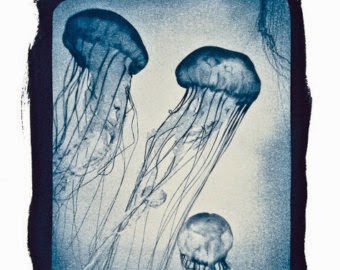Pre Work Project 7
12:56:00 PMCyanotype
The cyanotype process results in a blue image. This alternative process was first introduced to the photography world by Sir John Herschel. He fixed images using hyposulphite soda in 1839. He coated paper with iron salts and used it in contact printing. The paper was washed in water, resulting in the trademark white image on a deep blue background. The images appear painted on. (Source: Alternativephotography.com)
Cyanotype by Jake Groenhof:
Daguerrotype
Louis-Jacques-Mandé Daguerre presented his form of alternative print making to the French academy of sciences. Daguerre, a romantic painter and printmaker, named his iconic process of printing onto a highly polished silver plate a daguerrotype. (Source: Met Museum)
Boulevard by Louis-Jacques-Mandé Daguerre
Creating a gum and gum bichromate print results from painting on a gum arabic and watercolor solution onto a fixed print. The print is then soaked in water for a considerable amount of time. Once its done soaking, you scrape of the gum which leaves a tint to each image. (Source:gumphoto.co.uk)
The Flatiron by Edward Steichen
A polaroid transfer is the process of stripping the emulsion layer from an exposed polaroid image and placing it on another object, usually water color paper, giving your image a new shape and creating interesting manipulations. This process was pioneered by Edwin Land, the original inventor of the polaroid instant photography. (Source: Impossible Project)
Emulsion Lift by John Sargent Barnard











0 comments